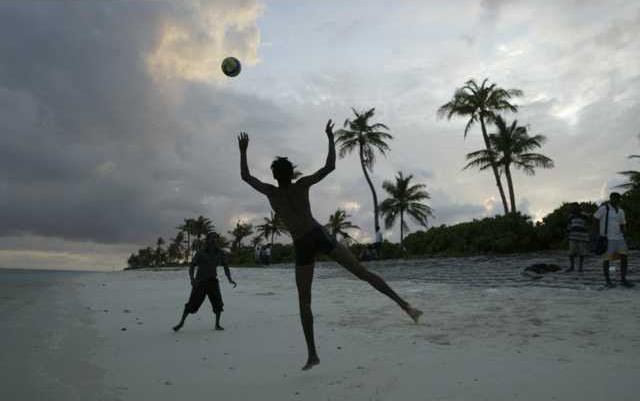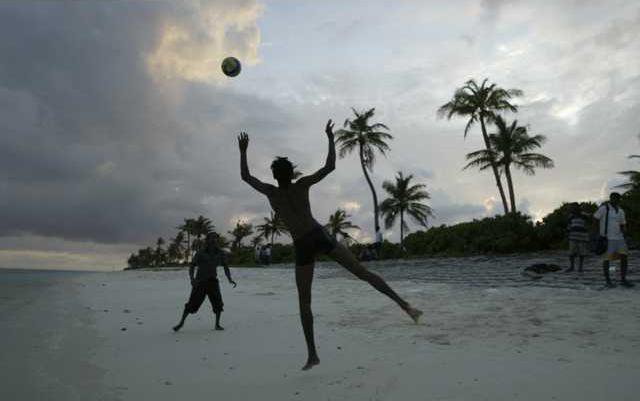HULHUMALE, Maldives — Running out of space in its crowded capital, this republic of 1,200 islands thought it had a can’t-miss solution: build another island.
Planners weren’t discouraged when people started eating the freshly planted palm saplings, or called the new island an ugly misfit among the picture-perfect beaches of their Indian Ocean archipelago. One day, they told themselves, the new island called Hulhumale would have it all: leafy streets, an artificial beach, a marina for megayachts, a luxury hotel and an entertainment strip.
Flash-forward a decade. Standing amid the empty, wind-swept expanse of crushed coral lots, the man charged with creating the island, Mahjoob Shujau, observes: ‘‘We all have hopes, we all have dreams.’’
And, as the 39-year-old bureaucrat knows all too well, there’s also reality — ‘‘We built it, but the people, they are not coming.’’
Considered sleepy even by the standards of this relatively slow-paced nation, Hulhumale (Hoo-la-MA-lay’) has attracted only about 5,000 people — plus a few donated cows — since the first houses went up in 2003. That’s far fewer than the 150,000 planners say could fit into the 465-acre island.
But the story of Hulhumale is no mere tale of thwarted government dreams; it’s a snapshot of a society in flux: a once poor and traditional society struggling to cope with an influx of tourism dollars and urbanization — challenges like overcrowding and unemployment unheard of here just two decades ago.
Most of the Maldives’ 360,000 people are scattered among some 200 islands, often fewer than 1,000 to an island with little to do apart from fishing.
The young and ambitious head for Male — the little country’s big city, a mini-metropolis that can be crossed on foot in about 30 minutes beach-to-beach. Its pastel apartment blocks, modern mosques, glass office towers and late-night alcohol-free cafes give Male (MA-lay’) the feel of a Muslim Miami Beach. The few young men who can afford imported sports cars cruise the streets but traffic rarely moves faster than 20 mph.
One reason people stay out late is, there’s often no room at home.
The capital’s population has nearly doubled to more than 100,000 in the past decade, making it one of the world’s most crowded cities. Space is so scarce that the yearly rent on a typical two-bedroom apartment is often more than triple the average per capita income of $2,700, forcing friends, family and even strangers to share.
Ibrahim Ali, a 26-year-old store clerk who moved here from a remote atoll six years ago, shares a room with eight other young men. They sleep in shifts. ‘‘Four of us have early work and they sleep at this time,’’ he says over a plate of tuna and eggs at a seaside cafe at 2 a.m. on a Monday. ‘‘I go to bed late and sleep in the morning.’’ His workday starts at noon.
Ali is precisely the kind of person officials thought would move to Hulhumale, where rents are about 30 percent cheaper and there’s plenty of space.
So why not move? ‘‘It’s too dead over there, man! There’s nothing to do,’’ he says.
As for the dormitory-like apartment blocks built by the government on the one inhabited corner of the island — ‘‘the flats are like prisons,’’ he says.
Then there is the commute to work in Male, a breezy, 20-minute trip across azure waters in a wooden motorboat. But islanders aren’t used to commuting.
‘‘Maldivian people like to work close to their homes. People want to go to their homes to eat lunch. Many days they take a nap,’’ says Shujau, the civil servant. ‘‘They don’t like to go out in the rain.’’
As for those ill-fated palms, he says, ‘‘the people, they eat the centers, the hearts. They are a delicacy here.’’ So the island’s greenery is mostly scrub and wispy trees imported from India, whose southern tip is some 300 miles to the east.
The almost rectangular island is built on sand dredged from the seabed and dumped in the shallows near a reef. It is more than six feet above sea level — double the height of average Maldivian islet — to protect it against rising seas.
Hulhumale does have a few fans. Abdul Sodiq moved here three years ago with his parents and immediately fell in love with its wide and empty roads, perfect for speeding around on his motorcycle.
‘‘Can you hear it?’’ the 20-year-old shouts, revving his bike’s engine. It’s probably loud enough to be heard on the other side of the island. He releases the clutch and quickly hits speeds unimaginable on Male’s crowded roads.
And then there is Ramiz Mustafa, 40, who bought a three-bedroom apartment in Hulhumale four years ago.
Sure, the island is ‘‘ugly,’’ he says. But ‘‘it is a good investment, the best in the Maldives’’ because it’s been built high enough to withstand rising seas.
But if the worst-case global warming scenarios come true, an extra three feet won’t matter — Hulhumale, too, could find itself under water by the end of the century.
Planners weren’t discouraged when people started eating the freshly planted palm saplings, or called the new island an ugly misfit among the picture-perfect beaches of their Indian Ocean archipelago. One day, they told themselves, the new island called Hulhumale would have it all: leafy streets, an artificial beach, a marina for megayachts, a luxury hotel and an entertainment strip.
Flash-forward a decade. Standing amid the empty, wind-swept expanse of crushed coral lots, the man charged with creating the island, Mahjoob Shujau, observes: ‘‘We all have hopes, we all have dreams.’’
And, as the 39-year-old bureaucrat knows all too well, there’s also reality — ‘‘We built it, but the people, they are not coming.’’
Considered sleepy even by the standards of this relatively slow-paced nation, Hulhumale (Hoo-la-MA-lay’) has attracted only about 5,000 people — plus a few donated cows — since the first houses went up in 2003. That’s far fewer than the 150,000 planners say could fit into the 465-acre island.
But the story of Hulhumale is no mere tale of thwarted government dreams; it’s a snapshot of a society in flux: a once poor and traditional society struggling to cope with an influx of tourism dollars and urbanization — challenges like overcrowding and unemployment unheard of here just two decades ago.
Most of the Maldives’ 360,000 people are scattered among some 200 islands, often fewer than 1,000 to an island with little to do apart from fishing.
The young and ambitious head for Male — the little country’s big city, a mini-metropolis that can be crossed on foot in about 30 minutes beach-to-beach. Its pastel apartment blocks, modern mosques, glass office towers and late-night alcohol-free cafes give Male (MA-lay’) the feel of a Muslim Miami Beach. The few young men who can afford imported sports cars cruise the streets but traffic rarely moves faster than 20 mph.
One reason people stay out late is, there’s often no room at home.
The capital’s population has nearly doubled to more than 100,000 in the past decade, making it one of the world’s most crowded cities. Space is so scarce that the yearly rent on a typical two-bedroom apartment is often more than triple the average per capita income of $2,700, forcing friends, family and even strangers to share.
Ibrahim Ali, a 26-year-old store clerk who moved here from a remote atoll six years ago, shares a room with eight other young men. They sleep in shifts. ‘‘Four of us have early work and they sleep at this time,’’ he says over a plate of tuna and eggs at a seaside cafe at 2 a.m. on a Monday. ‘‘I go to bed late and sleep in the morning.’’ His workday starts at noon.
Ali is precisely the kind of person officials thought would move to Hulhumale, where rents are about 30 percent cheaper and there’s plenty of space.
So why not move? ‘‘It’s too dead over there, man! There’s nothing to do,’’ he says.
As for the dormitory-like apartment blocks built by the government on the one inhabited corner of the island — ‘‘the flats are like prisons,’’ he says.
Then there is the commute to work in Male, a breezy, 20-minute trip across azure waters in a wooden motorboat. But islanders aren’t used to commuting.
‘‘Maldivian people like to work close to their homes. People want to go to their homes to eat lunch. Many days they take a nap,’’ says Shujau, the civil servant. ‘‘They don’t like to go out in the rain.’’
As for those ill-fated palms, he says, ‘‘the people, they eat the centers, the hearts. They are a delicacy here.’’ So the island’s greenery is mostly scrub and wispy trees imported from India, whose southern tip is some 300 miles to the east.
The almost rectangular island is built on sand dredged from the seabed and dumped in the shallows near a reef. It is more than six feet above sea level — double the height of average Maldivian islet — to protect it against rising seas.
Hulhumale does have a few fans. Abdul Sodiq moved here three years ago with his parents and immediately fell in love with its wide and empty roads, perfect for speeding around on his motorcycle.
‘‘Can you hear it?’’ the 20-year-old shouts, revving his bike’s engine. It’s probably loud enough to be heard on the other side of the island. He releases the clutch and quickly hits speeds unimaginable on Male’s crowded roads.
And then there is Ramiz Mustafa, 40, who bought a three-bedroom apartment in Hulhumale four years ago.
Sure, the island is ‘‘ugly,’’ he says. But ‘‘it is a good investment, the best in the Maldives’’ because it’s been built high enough to withstand rising seas.
But if the worst-case global warming scenarios come true, an extra three feet won’t matter — Hulhumale, too, could find itself under water by the end of the century.

